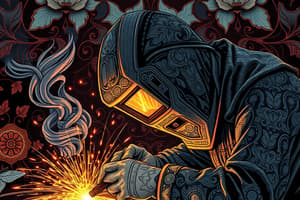Podcast
Questions and Answers
What is a Heat Exchanger?
What is a Heat Exchanger?
A device that transfers heat from one substance to another.
What does an Induced Draft Motor do?
What does an Induced Draft Motor do?
Vents flue gases that are generated from the burning process of fossil fuels.
What is the function of a High Limit Switch?
What is the function of a High Limit Switch?
A safety device allowing operation within a specified temperature range.
What is a Gas Valve?
What is a Gas Valve?
What are Burners used for?
What are Burners used for?
What is the purpose of a Circuit Board in a gas furnace?
What is the purpose of a Circuit Board in a gas furnace?
What is a Blower and Blower Motor?
What is a Blower and Blower Motor?
What does a Flue Pipe do?
What does a Flue Pipe do?
What is a Door Switch?
What is a Door Switch?
What is the role of a Rollout Switch?
What is the role of a Rollout Switch?
What is a Flame Sensor?
What is a Flame Sensor?
What does a Transformer do?
What does a Transformer do?
What is a Pressure Switch?
What is a Pressure Switch?
Flashcards
Heat Exchanger
Heat Exchanger
Transfers heat from one substance to another.
Induced Draft Motor
Induced Draft Motor
Vents flue gases produced by burning fossil fuels.
High Limit Switch
High Limit Switch
A safety device ensuring operation within a set temperature range.
Gas Valve
Gas Valve
Signup and view all the flashcards
Burners
Burners
Signup and view all the flashcards
Circuit Board
Circuit Board
Signup and view all the flashcards
Blower and Blower Motor
Blower and Blower Motor
Signup and view all the flashcards
Flue Pipe
Flue Pipe
Signup and view all the flashcards
Door Switch
Door Switch
Signup and view all the flashcards
Rollout Switch
Rollout Switch
Signup and view all the flashcards
Flame Sensor
Flame Sensor
Signup and view all the flashcards
Transformer
Transformer
Signup and view all the flashcards
Pressure Switch
Pressure Switch
Signup and view all the flashcards
Study Notes
Gas Furnace Components
- Heat Exchanger: Transfers heat between two substances, ensuring efficient heating within the furnace.
- Induced Draft Motor: Responsible for venting flue gases produced during fossil fuel combustion, contributing to safety and efficiency.
- High Limit Switch: A safety mechanism that ensures furnace operation remains within a designated temperature range, preventing overheating.
- Gas Valve: Regulates and controls the flow of gas into the burners, critical for safe and efficient operation.
- Burners: Final component for delivering gas or gas-air mixtures to the combustion zone, crucial for effective heating.
- Circuit Board: Manages the sequence of operations necessary for the furnace's proper functioning, coordinating various components.
- Blower and Blower Motor: A centrifugal fan powered by a motor that circulates air throughout the heating system, enhancing air distribution.
- Flue Pipe: Conducts flue gases from the combustion process out of the furnace, essential for ventilation and safety.
- Door Switch: A safety feature that disables the furnace when the access door is removed, protecting users from accidental exposure.
- Rollout Switch: Stops furnace operation if flames escape the combustion chamber, acting as a critical safety device.
- Flame Sensor: Utilizes various technologies (heat, infrared, light) to detect flame presence, ensuring fire safety and operational accuracy.
- Transformer: Modifies voltage within the system to ensure compatibility with various electrical components.
- Pressure Switch: Opens and closes based on pressure changes, part of safety and operational protocols within the furnace system.
Studying That Suits You
Use AI to generate personalized quizzes and flashcards to suit your learning preferences.




